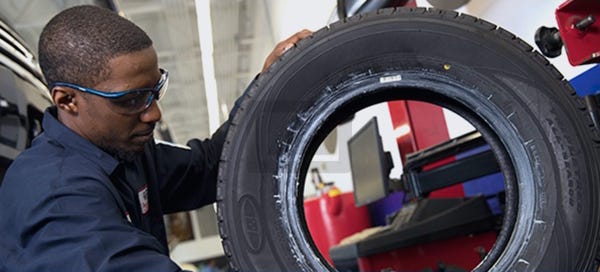Elevate Your Experience: Count On Morris Tires for GMC Tires Service
Elevate Your Experience: Count On Morris Tires for GMC Tires Service
Blog Article
Tire Solution: The Influence of Weather
When it comes to making certain optimum performance and safety when traveling, recognizing the impact of climate condition on tire service is essential. From scorching warm to icy roadways, each weather aspect can dramatically affect tire functionality and total driving experience. By delving into the results of differing weather on tires, vehicle drivers can gain valuable insights that might improve their vehicle's efficiency and long life. In this discussion, we will discover the detailed connection in between weather problems and tire solution, clarifying the importance of weather-specific tire upkeep practices and factors to consider.
Warm and Tire Efficiency
When revealed to high temperature levels, tires experience adjustments in efficiency that can substantially affect automobile safety and security and handling. The warm produced from extended driving or warm weather condition problems causes the tire rubber to soften, leading to minimized tread life and increased wear.

Winter Effects
Winter conditions can have a considerable influence on tire efficiency and security. As temperature levels decrease, tire rubber can harden, resulting in lowered traction on icy or snow-covered roads. In cool weather condition, tires might also shed air stress much more rapidly, which can affect handling and fuel effectiveness. In addition, cool temperature levels can create tire sidewalls to stiffen, boosting the danger of damages from splits or other road dangers.
To mitigate the results of chilly climate on tires, it is essential to routinely inspect tire pressure and inflate them to the manufacturer's suggested levels. Using winter season or all-season tires developed for winter problems can also improve traction and hold on icy or snowy roadways. Proper tire maintenance, consisting of routine evaluations for wear and damages, comes to be much more important during colder months to ensure ideal efficiency and safety.
Rainy Issues Effect
During rainy conditions, tire efficiency and security can be significantly influenced by the wet roadway surfaces and lowered visibility. The tread pattern of tires plays a critical function in keeping traction on damp roads. Tires with damaged treads are a lot more prone to hydroplaning, where a layer of water accumulates in between the tire and the road surface area, causing loss of grip. To combat this, vehicle drivers must consistently examine their tires for adequate tread deepness and think about visite site buying tires specifically designed for wet problems.
In addition, stormy weather can likewise reduce about his exposure, making it testing for chauffeurs to see the road in advance plainly (GMC Tire Service). In such problems, it is vital to adjust driving speeds accordingly and maintain a secure adhering to distance to enable abrupt stops. Effectively inflated tires can likewise aid in keeping control on damp roadways by providing far better handling and hold
Snow and Tire Safety And Security
When driving in snowy conditions, having the best tires can make a substantial difference in security and performance. Winter months tires are designed with special rubber compounds and walk patterns to provide much better traction on snow and ice compared to all-season tires.

It is essential to adhere to manufacturer directions when mounting and making use of tire chains to prevent damages to the tires and automobile. By choosing the appropriate tires, keeping proper rising cost of living, and considering extra traction aids like tire chains, motorists can boost their safety and security when browsing snow-covered roads.
Weather-Related Tire Upkeep
Weather-related tire upkeep includes a variety of practices intended at guaranteeing ideal tire feature and durability in various weather condition scenarios. One essential element of weather-related tire upkeep is tire stress law. Examining tire step on a regular basis and changing tires when step wear gets to a particular deepness is essential for preserving traction and stability in negative weather.
Conclusion
To conclude, weather have a considerable effect on tire efficiency and safety and security. From warmth impacting tire pressure and use to cool climate lowering grip, it is necessary look at this site to think about the weather when keeping and utilizing tires. Stormy conditions can lower grasp and bring about hydroplaning, while snow can increase the risk of accidents if tires are not appropriately geared up. Weather-related tire upkeep is vital in guaranteeing ideal performance and security when driving.
In this conversation, we will explore the intricate connection between weather condition conditions and tire solution, dropping light on the relevance of weather-specific tire upkeep techniques and factors to consider.

Report this page